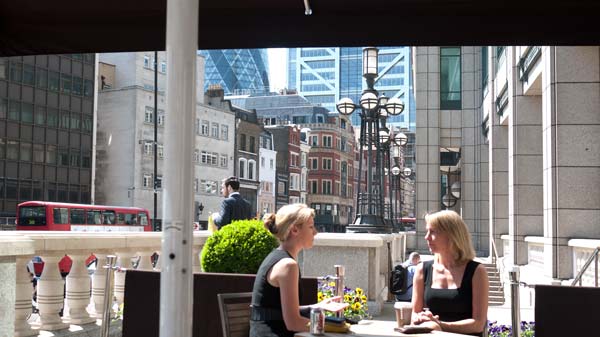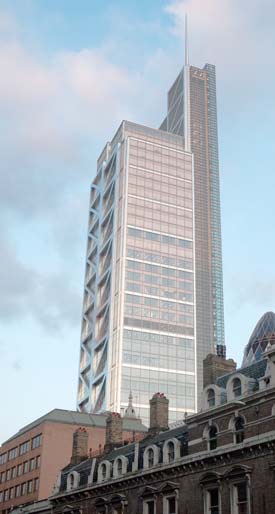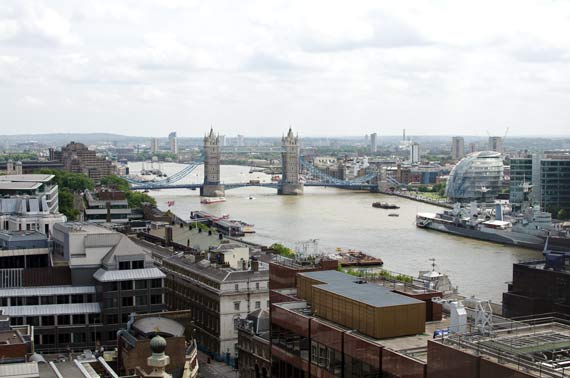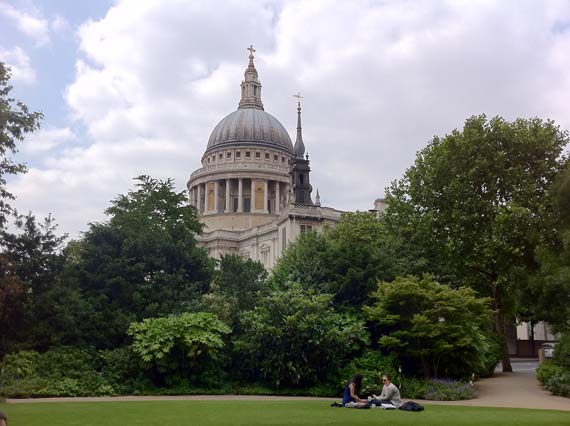
Fairy Tale London
Ah, the beautiful buildings of fairy tale London. Aren’t they terrific?
This photo shows the spires of the renovated St. Pancras Station peeping out from behind the forecourt of the recently renovated British Library in London.
St. Pancras Station was famously saved from demolition by the poet John Betjaman, who mounted a campaign to save the station.
His statue stands on the upper floor of the station, where he is gazing up at the roof – although of course what was really intended to be conveyed was of him gazing up at the outside of the station.

John Betjaman had strong views on architecture – particularly what he saw as the bad architecture that was intent on destroying English towns.
Shortly before the Second World War, he wrote a poem about the English town of Slough:
Come, friendly bombs, and fall on Slough!
It isn’t fit for humans now,
There isn’t grass to graze a cow.
Swarm over, Death!Come, bombs and blow to smithereens
Those air -conditioned, bright canteens,
Tinned fruit, tinned meat, tinned milk, tinned beans,
Tinned minds, tinned breath.Mess up the mess they call a town-
A house for ninety-seven down
And once a week a half a crown
For twenty years.And get that man with double chin
Who’ll always cheat and always win,
Who washes his repulsive skin
In women’s tears:And smash his desk of polished oak
And smash his hands so used to stroke
And stop his boring dirty joke
And make him yell.But spare the bald young clerks who add
The profits of the stinking cad;
It’s not their fault that they are mad,
They’ve tasted Hell.It’s not their fault they do not know
The birdsong from the radio,
It’s not their fault they often go
To MaidenheadAnd talk of sport and makes of cars
In various bogus-Tudor bars
And daren’t look up and see the stars
But belch instead.In labour-saving homes, with care
Their wives frizz out peroxide hair
And dry it in synthetic air
And paint their nails.Come, friendly bombs and fall on Slough
To get it ready for the plough.
The cabbages are coming now;
The earth exhales.
To explain:’Ninety seven down’ refers to £97.00 deposit to buy a property with a mortgage and, ‘half a crown’ was a coin whose value was one eighth of a pound.
Betjaman was criticised heavily at the time for even talking about the possibility of bombs falling on an English town (something that became all too true just a couple of years later).
He was also criticised for what was seen as his upper-class attitude that wanted to preserve England as some pleasant idyll that in reality meant hardship for the ordinary man in the street.
I think he just knew terrible architecture when he saw it.
The History Of Mr. Polly
The mention in the poem of the poor young men who “daren’t look up and see the stars” reminds me of the theme of the novel ‘The History of Mr. Polly’ written by H.G. Wells in 1910.
In it, the hero – a poor downtrodden wisp of a man – escapes a life of drudgery and finds his own tune to which to dance through life.
In some ways it all seems so long ago. In modern England, everyone is free, free to buy what they want and to behave as they want. All the strictures of class divisions seem laughable – but they should are still there.
The Man Who Could Work Miracles
For another look at H.G. Wells’ views on the way the world works, there is the story of what happens when the gods grant a draper’s assistant unlimited power.
Rather, they grant George McWhirter Fotheringay unlimited power except power over the human heart.
He starts out bemused by his powers and is given advice from every quarter. In the end he decides for himself what to do with his powers.
Here’s a full-length film version of his The Man Who Could Work Miracles – unfortunately missing the last half minute or so when the gods talk about what has happened…
Look Out, We’re Surrounded
Two and a half miles (4km) from St. Pancras station, lies Bishopsgate – a street close to the heart of the financial district of the city.
I sipped my coffee on a terrace cafe and looked out at the old buildings.
For a while I was blind to what was behind them.
Then I saw, from under the lip of the large umbrella over my table – like something from the War Of The Worlds – a ring of glass and steel skyscrapers surrounding the old buildings.

On the left is the ‘Gherkin’ building, where council workers work. But for the most part the buildings house businesses, like the Heron Tower that you can also see in the photo and again in the photo below.

Do you feel dwarfed and rebuffed by these sleek modern buildings?
Tamara and I do. It’s not that we dislike modern glass and steel buildings per se, but the way the new buildings dwarf the old is unappealing.
We like buildings on a human scale.
Just because people can build huge buildings, doesn’t mean people have to build huge buildings, does it?
We modern humans may be taller than our ancestors, but we are not that much taller or bigger, are we?
Tamara and I feel the same way about large, empty city squares surrounded by monolithic buildings.
When they are filled with people, they can be lovely. But take away the crowds and large empty squares seem to be products of an idea that has forgotten its human roots.
Of Course, There Are Fine Buildings Too
There are fine buildings and other fine structures in London, of course, and some fine views. And some of them are large structures – but the detail seems to make them more accessible, less like glass mountains.
Here are views of the Thames that I shot for the article Six Angles To Shoot London.



For more images of urban appeal, take a look at these ecards featuring city buildings and urban landscapes that we have photographed on our travels around the world.
From England’s Stonehenge in Wiltshire and the Sheldonian Theatre in Oxford to France’s bookseller’s stall on the banks of the Seine in Paris, to Israel and a walkway to the Temple Mount in Jerusalem; they are all here – captured as images for our ecards.